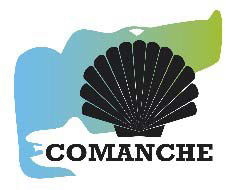ANR COMANCHE
People involved
Interactions écosystémiques et impacts anthropiques dans les populations de COquilles Saint‐Jacques (Pecten maximus) de la MANCHE
The King scallop Pecten maximus constitutes the first landed species in terms of tonnage and the second or third one in terms of value for the French fisheries. More than 90% of these landings come from the English Channel indicating that its exploitation is essential to local fleets. The COMANCHE project (Ecosystem Interactions and anthropogenic impacts on King scallops populations in the English Channel) proposed to improve the knowledge of the scallop within the Channel, through an ecosystem‐based approach for fisheries, appealing to a wide range of scientific disciplines (physics, chemistry, genetics, ecology, geostatistics, modeling, economics ....). Researches on the spatial location of scallop beds, connectivity by larval dispersal between beds, life history and recruitment variability, dynamics of plankton communities and determinism of toxic algal blooms, place of this bivalve in the food web, development of invasive species like the American slipper limpet, impact of dredging on seabed and also analysis of the main market supplies for this species, have been conducted. The aim of this project was to contribute to a sustainable development of a fishery, supported by government, local authorities and stakeholders’ associations. According to the research activities, different conceptual approaches and tools, as numerical modeling methods, mapping, molecular biology techniques, use of genetic markers, laboratory cultivations of algae, etc ... have been used. For this, the COMANCHE project was built on the use of in situ data, but also on biological data time‐series collected during scientific sea surveys conducted for more than 30 years by Ifremer or on data collected during the project. Data coming from the declarative flow (fisheries statistics) of fishing vessels have also been used. A map of the connectivity between the different scallop populations has been proposed, highlighting three major functional units (Bay of Seine, Normand‐Breton Gulf and Southwestern coast of England). It was shown that the influence of the sea surface temperature and related climatic indexes could explain inter‐annual fluctuations of the recruitment for the stock in the Bay of Seine, probably because of the role of temperature on the gametogenesis and the early life stages. Significant progresses have been made in understanding the emergence of harmful algal blooms which affect the scallop fisheries. Over 70 strains of 4 different species of Pseudo‐ nitzschia were isolated from samples taken in the Bay of Seine and were kept in culture. A biochip for the rapid identification of different species of Pseudo‐Nitzschia was developed and could be used for the biomonitoring of toxic phytoplankton. An ecosystem model coupled with a biogeochemical model and a population dynamics model was developed for English Channel scallop populations. The economic analysis of fisheries raises the question of the adequacy of the management measures and the operation of the market in a global context of the King scallop production increase.
Coordination: Eric Foucher, Ifremer Port-en-Bessin
- Ifremer
- UPMC/Station Biologique de Roscoff
- UBO/LEMAR
- UCN, Juliette FAUCHOT, UMR BOREA
- UCN, Pascal CLAQUIN, UMR BOREA

